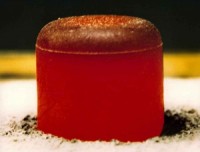Nuclear Power - Powering the Deep Space Exploration
Editor's note: In his last post Chris Morrison wrote about the two parts of the RTG. The following is the second part of the RTG submission complete with videos.
The NASA Multi-Mission-RTG
NASA has developed a generic Multi-Mission RTG (MMRTG) which can be used for a large variety of missions throughout the Solar System. You can think of the MMRTG as the current model of the RTG which is currently used in the Curiosity Rover and is planned for the Mars 2020 Rover. The MMRTG uses 4.8 kg (10.8 lb) of Pu-238 to provide 2.4 kW of heat. The NASA video below shows what the MMTRG looks like on the inside:
https://www.youtube.com/watch?v=4qkvoVRdoNg
The Advanced Stirling Radioisotope Generator
The Advanced Stirling Radioisotope Generator (ASRG) is like the RTG but instead of using thermoelectrics for turning heat into electricity, the ASRG uses an engine with a piston known as a Stirling engine. The Stirling engine can convert about four times more of the heat into electricity than the thermoelectric generator which could open new higher power mission opportunities or help conserve Pu-238. A development version of the ASRG was developed at NASA Glenn Research Center, but there are no current plans to develop a flight model.
https://www.youtube.com/watch?v=dizf5OanlzY
Pu-238 Manufacturing
Pu-238 is manufactured into pellets at Los Alamos and Idaho National Laboratories. Rob O'Brien from Idaho National Laboratory talks about some of the facilities for making Pu-238 in the video below:
https://www.youtube.com/watch?v=IJTMoSwh5fM
RTG Safety
The Pu-238 is indeed very radioactive. Luckily the Pu-238 mostly emits a type of radiation known as an alpha particle. Alpha particles are very easy to stop. In fact the skin on your body will block the alpha particles. The major risk to humans is from inhaling or eating Pu-238. In light of this NASA has made the Pu-238 resistant to release even in the event of a catastrophic rocket launch failure.

Red hot Pu-238 pellet. Credit: Department of Energy
First the Pu-238 is combined to oxygen to form Plutonium Oxide (PuO2) which is a ceramic that is not water soluble and resistant to melting and cracking into small pieces. Second the PuO2 pellet is then encased into an iridium metal cladding and then into several layers of high temperature graphite. Finally an aero-shell is placed around the pellets that ensure they will not burn up re-entering Earth's atmosphere. All these precautions make sure that the Pu-238 can stay intact and safely contained even in the event of a catastrophic rocket explosion, hot fire, or other events that could happen during launch.
During the Apollo 13 mission the SNAP-27 RTG re-entered Earth's atmosphere at a high speed and fell into the deep Pacific Ocean. After carefully monitoring the water and air it was concluded that the RTG released no detectable Pu-238 into the environment and was assumed to be intact sitting somewhere at the bottom of the Ocean. In 1968 another RTG launched from Vandenberg Air Force Base was successfully recovered intact after a launch failure.
Before 1965 the graphite and Iridium protection shells were not used. In 1964 the US Transit 5BN-3 satellite failed to reach orbit and re-entered the atmosphere. Trace amounts of Pu-238 were detected near Madagascar. The Pu-238 was dispersed over such a wide area that it was not detected in sufficient quantity to pose a risk but in the interest of safety all new RTG missions were required to have protective layers that would keep the Pu-238 in the RTG intact and contained.
Plutonium 238 Supply Challenges
Plutonium 238 was a waste byproduct produced during the Cold War when the US and the USSR were attempting to Produce Plutonium 239 for weapons (Plutonium 238 is not used in nuclear weapons). Since the Cold Wars there hasn't been very much of produced and. It is now very expensive, costing over 3 million dollars per kilogram (about 1.5 million per pound) because it is in short supply.
There is some hope to restart production of Pu-238. Recently Oak Ridge National Laboratory was mandated by congress to restart the production of Pu-238 producing around 1 kg per year. That would mean that there will be enough Pu-238 to complete one to two major missions every ten years. The next RTG powered NASA project is the Mars 2020 rover which is a twin of the Curiosity rover. It will use around 5 kg of Pu-238.
Other Radioisotope Options
Americium-241 (Am-241) is commonly used in smoke detectors. Micrograms (on one millionth of a gram) are used to use radiation to detect smoke on the air. Americium is currently being considered for use in RTG's by the European Space Agency for a lower cost option. While not as good as Pu-238 (approximately 4 times more mass is needed to produce the same power as Pu-238) it could do the job.
Another possibility is the kilopower nuclear fission power system currently being worked on at Los Alamos National Laboratory. Because of the cost of Plutonium it may be worth considering a more complex fission power system.
To learn more about Radioisotope Power Systems visit the NASA website: NASA Radioisotope Power Systems website.
Chris is a space enthusiast currently in his fourth year of his Ph.D. pursuit from Rensselaer Polytechnic Institute and holds a B.S. from Embry Riddle Aeronautical University in Aerospace Engineering and Computer Science. Chris is also training for his senior reactor operator license, and works on an educational startup Learn-Blitz.com on weekends. He is currently on the Executive Committee (and webmaster) for the ANS Aerospace Division.

